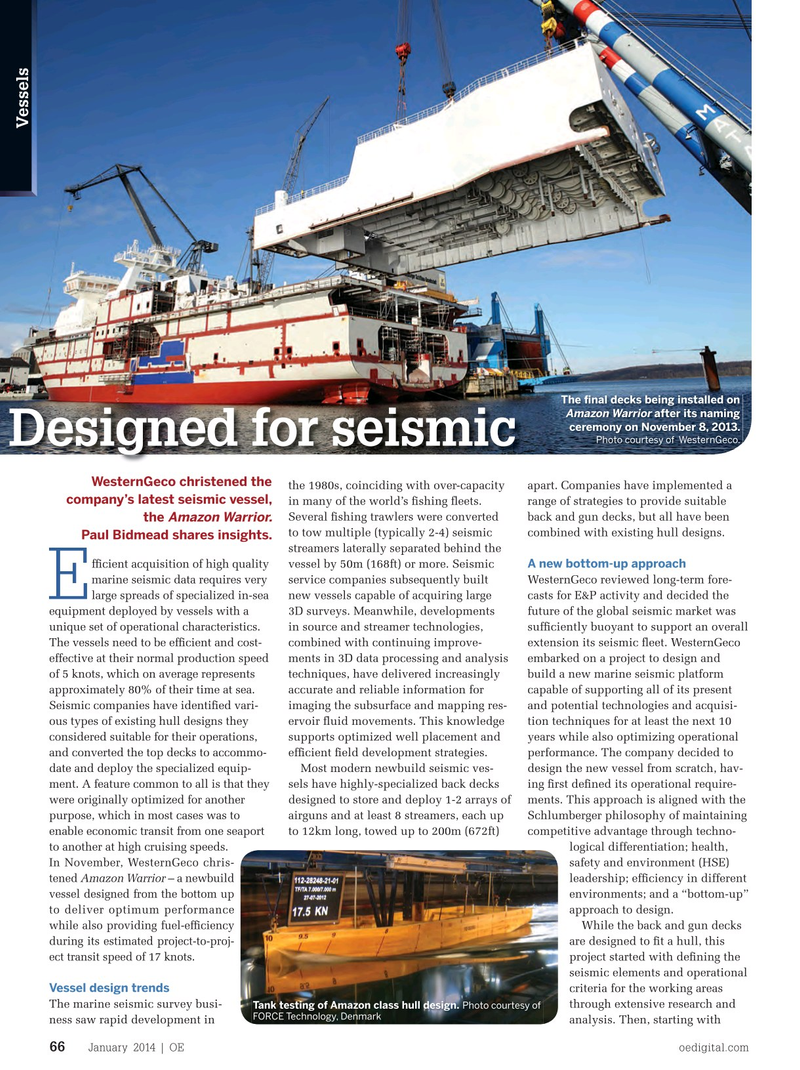
Page 64: of Offshore Engineer Magazine (Jan/Feb 2014)
Read this page in Pdf, Flash or Html5 edition of Jan/Feb 2014 Offshore Engineer Magazine
clean sheet of paper and no preconceived ideas, engineers were tasked with design- ing a hull, propulsion system, and all the other vessel components required to optimally meet the seismic require-
Vessels ments while making sure that there were no compromises in HSE or operational ef? ciency.
People power
A key feature of the design process, especially for the back and gun decks, was that it involved considerable input from experienced equipment users. The extensive WesternGeco HSE knowl- edge management database was used to evaluate and mitigate potential safety risks identi? ed from a wide range of industry incidents and les- sons learned. Workshops were orga- nized that brought together design- ers, management, and numerous
The ? nal decks being installed on crew members with up-to-date and
Amazon Warrior after its naming relevant experience of the various ceremony on November 8, 2013.
elements of marine seismic opera-
Photo courtesy of WesternGeco.
Designed for seismic tions. HSE was a top design priority.
The ? rst Amazon-class vessel is
WesternGeco christened the the 1980s, coinciding with over-capacity apart. Companies have implemented a being built in Flensburg, Germany. company’s latest seismic vessel, in many of the world’s ? shing ? eets. range of strategies to provide suitable The shipyard has been using 3D
Several ? shing trawlers were converted back and gun decks, but all have been visualization technology in its the
Amazon Warrior. to tow multiple (typically 2-4) seismic combined with existing hull designs. design processes for more than 12
Paul Bidmead shares insights. streamers laterally separated behind the years. Initial designs were used to create f? cient acquisition of high quality vessel by 50m (168ft) or more. Seismic virtual versions of specialist working
A new bottom-up approach marine seismic data requires very service companies subsequently built WesternGeco reviewed long-term fore- environments, in which crews were able
E large spreads of specialized in-sea new vessels capable of acquiring large casts for E&P activity and decided the to provide realistic feedback on prac- equipment deployed by vessels with a 3D surveys. Meanwhile, developments future of the global seismic market was ticalities such as equipment handling, unique set of operational characteristics. in source and streamer technologies, suf? ciently buoyant to support an overall stepping, handling, and the safe move-
The vessels need to be ef? cient and cost- combined with continuing improve- extension its seismic ? eet. WesternGeco ment of people and equipment.
effective at their normal production speed ments in 3D data processing and analysis embarked on a project to design and The ? nal vessel design addresses of 5 knots, which on average represents techniques, have delivered increasingly build a new marine seismic platform operational and HSE issues in all areas. approximately 80% of their time at sea. accurate and reliable information for capable of supporting all of its present Seismic and maritime workshops, stores,
Seismic companies have identi? ed vari- imaging the subsurface and mapping res- and potential technologies and acquisi- and supply handling

 63
63

 65
65